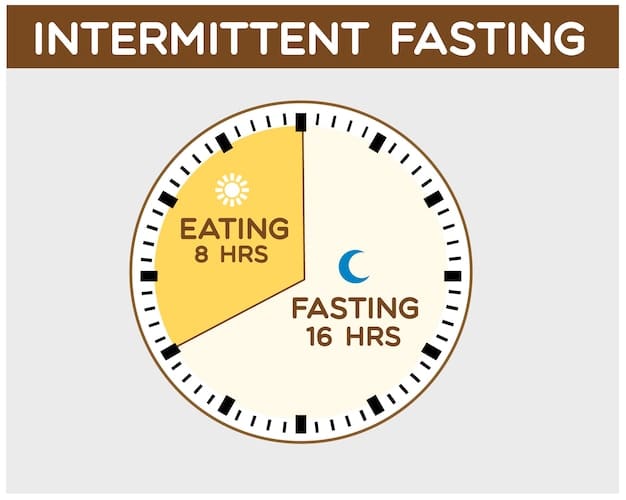Intermittent Fasting for Men: Your 16/8 Method Guide for 2025

Intermittent Fasting for Men: The Complete 16/8 Method Guide for 2025 offers a structured approach to weight management and overall health enhancement. Learn how to safely and effectively implement this popular fasting schedule.
Ready to transform your health and fitness with a simple, effective strategy? The 16/8 method of intermittent fasting could be exactly what you need.
This guide will walk you through everything you need to know to get started, making Intermittent Fasting for Men: The Complete 16/8 Method Guide for 2025 accessible and achievable.
Understanding Intermittent Fasting for Men
Intermittent fasting (IF) isn’t a diet; it’s an eating pattern. It revolves around cycling between periods of eating and voluntary fasting on a regular schedule.
Among the various methods, the 16/8 method is particularly popular, especially for men, due to its simplicity and ease of integration into daily life. Let’s delve deeper into what makes it so effective.
What is the 16/8 Method?
The 16/8 method involves fasting for 16 hours and restricting your daily eating window to 8 hours. This doesn’t mean you have to starve yourself. Instead, you consume your daily calories within that 8-hour period.
Why is it Popular for Men?
Men often seek structured approaches to health and fitness. The 16/8 method provides this, coupled with potential benefits like muscle preservation during weight loss.
- Improved insulin sensitivity: Enhances the body’s ability to use insulin effectively.
- Weight Management: By restricting eating windows, it can naturally reduce calorie intake.
- Hormonal Benefits: May boost human growth hormone (HGH) which is key for muscle growth and repair.
In summary, understanding the basics of intermittent fasting and the 16/8 method sets the stage for implementing it effectively. It is a practical tool for men looking to optimize their health.

The Science Behind 16/8 Intermittent Fasting
While the 16/8 method might sound like another fad diet, it’s rooted in scientific principles. When you fast, your body undergoes several metabolic changes.
These changes can lead to various health benefits, particularly when consistently practiced. Here’s a look at the science supporting this approach.
Autophagy and Cellular Repair
During fasting, the body initiates autophagy, a process where it cleans out damaged cells to regenerate newer, healthier ones. This cellular “housekeeping” is crucial for optimal health.
Insulin Sensitivity and Blood Sugar Control
Fasting can improve insulin sensitivity, meaning your body needs less insulin to lower blood sugar levels. This is beneficial for preventing type 2 diabetes.
- Reduced Inflammation: Studies suggest IF can lower markers of inflammation in the body.
- Improved Brain Health: Some research indicates IF may boost brain function and protect against neurodegenerative diseases.
- Enhanced Fat Burning: With lower insulin levels, your body can tap into fat stores for energy more efficiently.
Scientific evidence increasingly supports the health benefits of intermittent fasting, especially the 16/8 method. It provides a solid foundation for men seeking to optimize their well-being through structured eating patterns.
Getting Started: A Step-by-Step Guide to 16/8
Implementing the 16/8 method doesn’t have to be complicated. With a few simple steps, you can seamlessly integrate it into your daily routine.
Whether you’re new to fasting or have experimented before, this guide will help you get started safely and effectively. Here’s a practical approach.
Choosing Your Eating Window
Decide on an 8-hour window that suits your lifestyle. A common approach is 12 pm to 8 pm, allowing you to skip breakfast but enjoy lunch and dinner.
Planning Your Meals
Focus on nutrient-dense foods during your eating window. Prioritize whole foods like lean proteins, vegetables, fruits, and whole grains. Proper nutrition is essential while doing Intermittent Fasting for Men: The Complete 16/8 Method Guide for 2025.
- Hydration: Drink plenty of water throughout the day, especially during the fasting period.
- Listen to Your Body: Pay attention to hunger cues and adjust your eating window if needed.
- Start Slowly: If you’re new to fasting, begin with a shorter fasting period (e.g., 12 hours) and gradually increase it.
This step-by-step guide simplifies the process of starting the 16/8 method, ensuring you can implement it safely and effectively. Remember to tailor it to fit your individual needs and lifestyle.
Maximizing Results: What to Eat During Your 8-Hour Window
What you eat during your 8-hour eating window can significantly impact the results you see with Intermittent Fasting for Men: The Complete 16/8 Method Guide for 2025.
Focusing on nutrient-dense foods ensures you get the vitamins, minerals, and macronutrients your body needs to thrive. Here’s a guide to making the most of your meals.
Prioritize Protein
Protein is essential for muscle repair and growth. Include sources like chicken, fish, beef, eggs, and plant-based options such as lentils and tofu.
Embrace Healthy Fats
Healthy fats support hormone production and overall health. Incorporate avocados, nuts, seeds, olive oil, and fatty fish into your diet.
- Load Up on Vegetables: Vegetables provide essential vitamins, minerals, and fiber, promoting satiety and overall well-being.
- Choose Complex Carbs: Opt for complex carbohydrates like whole grains, sweet potatoes, and legumes over refined grains and sugary foods.
- Stay Hydrated: Drink plenty of water, and consider incorporating green tea, which is high in antioxidants and may enhance fat burning.
The quality of your food choices during your eating window is just as important as the timing of your meals. Prioritizing nutrient-dense options ensures you get the most out of the 16/8 method.

Common Mistakes to Avoid with the 16/8 Method
While the 16/8 method is straightforward, certain missteps can hinder your progress. Awareness of these common mistakes will help you stay on track.
Avoiding these pitfalls ensures you maximize the health and fitness benefits of intermittent fasting. Here are a few things to watch out for.
Overeating During the Eating Window
Some individuals compensate for fasting by overeating during their 8-hour window. This can lead to weight gain and negate many of the benefits of IF.
Dehydration
Insufficient water intake can lead to fatigue, headaches, and decreased performance. Staying hydrated is crucial, especially during fasting periods.
- Poor Food Choices: Consuming primarily processed foods and sugary drinks during your eating window can undermine your health goals.
- Inconsistency: Sporadic fasting can disrupt your body’s natural rhythms and reduce the effectiveness of the method.
- Ignoring Your Body: It’s important to listen to your body and adjust the timing or duration of your fasts as needed.
Avoiding these common mistakes can significantly improve your experience and results with the 16/8 method. It’s about making informed choices and staying consistent.
Is 16/8 Intermittent Fasting Right for You? Considerations for Men in 2025
Before diving into the 16/8 method, it’s essential to consider whether it aligns with your individual health needs and lifestyle. Intermittent Fasting for Men: The Complete 16/8 Method Guide for 2025 is not a one-size-fits-all approach.
Certain health conditions and lifestyle factors may make it unsuitable for some. Here are some key considerations.
Medical Conditions
Individuals with diabetes, hypoglycemia, or a history of eating disorders should consult a healthcare professional before starting intermittent fasting.
Lifestyle Factors
Consider your daily schedule, stress levels, and activity level. The 16/8 method may not be suitable if you have a demanding physical job or high-stress lifestyle without adequate rest and nutrient intake.
- Age and Fitness Level: Older adults or those with certain fitness goals may need to adjust the method to suit their specific needs.
- Medications: Certain medications may interact with intermittent fasting, potentially causing adverse effects.
- Consulting a Professional: It’s always wise to consult with a healthcare provider or registered dietitian before making significant changes to your diet.
Deciding whether the 16/8 method is right for you involves careful consideration of your health status and lifestyle. When implemented thoughtfully, **Intermittent Fasting for Men: The Complete 16/8 Method Guide for 2025** can be a valuable tool for health enhancement.
| Key Point | Brief Description |
|---|---|
| ⏱️ Timing | Fast for 16 hours, eat within 8 hours daily. |
| 🍏 Nutrition | Prioritize nutrient-dense, whole foods in meals. |
| 💧 Hydration | Drink plenty of water and stay hydrated. |
| 🩺 Consultation | Consult a doctor before starting, especially if you have existing medical conditions. |
Frequently Asked Questions
The 16/8 method offers potential benefits such as improved insulin sensitivity, weight management, and cellular repair through autophagy. Many find it enhances their overall wellbeing.
Yes, you can consume black coffee or tea as they contain minimal calories and won’t break your fast. Avoid adding sugar, milk, or other caloric additions.
Results vary depending on individual factors such as diet, activity level, and consistency. Some may notice changes within a few weeks, while others may take longer.
Yes, exercise is generally safe and can complement the benefits of intermittent fasting. Consider scheduling workouts during your eating window for optimal energy levels.
Some individuals may experience temporary side effects such as hunger, fatigue, or irritability. These typically subside as your body adjusts to the new eating pattern. It is best to consult your Doctor.
Conclusion
In conclusion, **Intermittent Fasting for Men: The Complete 16/8 Method Guide for 2025** offers a structured and scientifically supported approach to enhancing your health and fitness. By understanding the principles, implementing them thoughtfully, and avoiding common mistakes you can optimize the path to wellness.
Remember to tailor the method to suit your unique needs, listen to your body, and consult with healthcare professionals when necessary. Armed with the knowledge and practical steps outlined in this guide, you’re well-equipped to make informed choices and embark on a healthier lifestyle.





